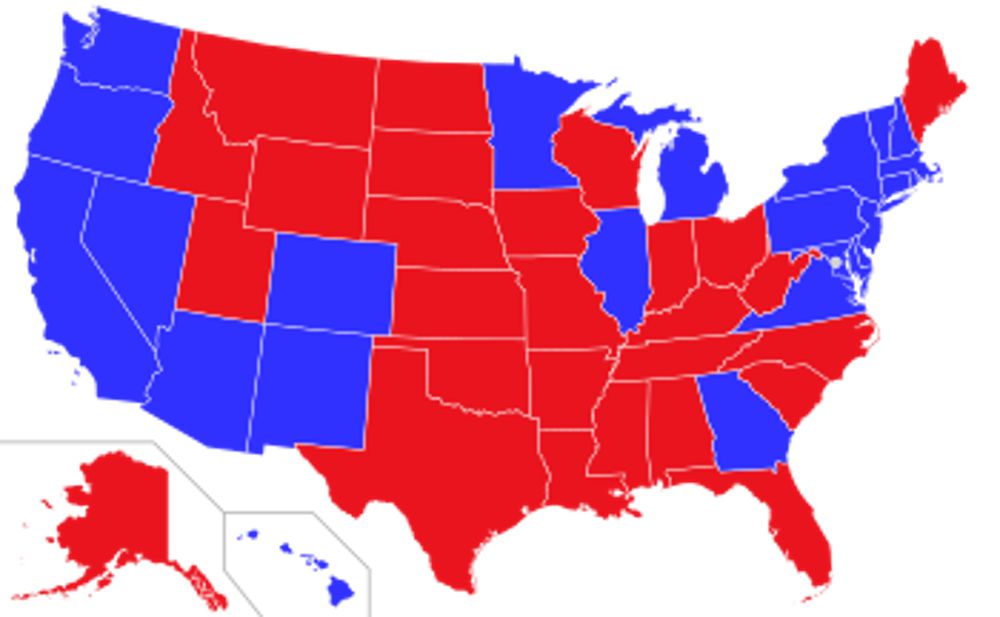Over its rich 247-year history, the United States of America has had its fair share of ups and downs, including a nationwide civil war that killed 620,000 Americans.
Today, 159 years after that war ended, Americans are worried another might be on their doorstep. And some political leaders are arguing that in order to stop a seemingly inevitable implosion, certain states, including California, should divorce the United States for good.
What Is the Difference Between Secession and National Divorce?

With the 2024 presidential elections looming, the United States is more divided than ever. It seems that it may once again be Biden vs. Trump, and each candidate appears to have more haters than they do supporters.
And with the prospect of either man in the Oval Office, there has been a lot of talk about “national divorce” from states such as Texas, California, and New Hampshire. But it’s important to understand that national divorce is just another term for secession.
Can a State Legally Secede?

According to the US Constitution, a state cannot secede from the nation. In fact, Texas tried to do so just after the Civil War in 1869 and was denied by the Supreme Court.
But that is not stopping these states from trying anyway. However, in order to successfully separate from the United States, California, Texas, New Hampshire, and whoever else wants to go will not only need the votes, but they’ll also need to fight for the “divorce” in a court of law.
New Hampshire Already Has a Plan

While everyone is talking about Texas and California, the tiny New England state of New Hampshire has been quietly planning its secession from the nation.
Republican representatives of the northern state have already introduced two pieces of legislation, CACR 20 and House Bill 1130. The CACR is an amendment to the Constitution that says NH will leave the USA if the country’s debt amounts to more than $40 trillion. And House Bill 1130 says the state is already studying the legal and economic aspects of “exerting its sovereign rights.”
What’s California’s Plan?

Meanwhile, California is taking a different approach through a grassroots organization called “Yes California.”
“Yes California” was founded in 2015, and now, its members are working on adding a measure called CalExit 3.1 to a future ballot. CalExit explains that the state will essentially break in two, half of which will remain a part of the United States, and the other will be a sovereign entity called Pacifica.
Yes California Founder Louis Marinelli Claims CalExit Will Stop a Civil War

Conservative activist Louis Marinelli founded Yes California in 2015, and he believes it will be necessary to cut the ties between what will be Pacifica and the United States in order to save the country from an internal war.
Marinelli told Newsweek, “So right now, we’re more working on the concept of national divorce as an alternative to potential civil violence and civil war in the country. Our belief is that there’s a lot of growing political violence and political problems in the country that may lead to fighting in the streets, civil war too, some people are calling for. We are trying to propose the idea of potentially doing a national divorce of some sort…to avoid that type of situation.”
Marinelli Said Now Isn’t the Best Time to Secede

In the same interview, Marinelli explained that while he and his team are working wholeheartedly on getting their plan for part of California to break away on a future ballot, they don’t believe now is the ideal time to secede.
Marinelli said, “Because of what’s happening [in Ukraine and] around the world and the possibility that the United States can be drawn into war, we think it would be counterproductive to Western civilization and the cause of democracy if we were also fighting within our own country.”
Marinelli’s Ex-Partner Is Saying Something Different

The Yes California organization also has some internal issues that it needs to sort out before it charges forward with its plan for secession. The biggest problem seems to be that while Marinelli believes he’s running things, his fellow co-founder Marcus Ruiz Evans recently told Newsweek that he is, in fact, the “real leader.”
And Evans has a very different plan for California. He told the press, “CalExit was always the idea of all of California leaving America,” not that just part of the state would secede.
CalExit Isn’t Happening Any Time Soon

While Evans, Marinelli, and their organization, Yes California, have been making headlines, there is no evidence to support the fact that either of their very different plans will come to fruition any time soon.
While there is no doubt that thousands, if not millions, of Californians, are frustrated with the federal government, a great deal of campaigning, organization, and legislation will need to be passed before the state can even think about breaking free.
Some Americans Believe the Country Should Just Split

In 2024, it’s difficult to find an American who doesn’t believe the country is in trouble. And while some states believe the best course of action is secession, others have a different plan in mind.
Instead of one state divorcing the other 49, one idea is that the entire country will split into two groups: The red Republican states as one country and the blue Democratic states as another.
Georgia Representative Marjorie Taylor Greene Has Publicly Agreed with the Idea

Georgian Republican representative Marjorie Taylor Greene spoke on Fox News in February of 2023 about this idea, claiming that she believes it is what will ensure the US doesn’t find itself in another civil war.
She said in the interview, “The last thing that I ever want to see in America is a civil war. No one wants that…but it’s going that direction, and we have to do something about it.” Greene also wrote on an X post, “Soon national divorce may be our only option.”
What’s Next for the United States of America?

It’s crucial to understand that while talk of secession is seemingly more prevalent than it has been in more than 150 years, there is still no sign that any of the United States will break away any time soon.
As mentioned, there will have to be a significant amount of legislation passed, votes accumulated, and even probably a several-year-long court case before the Supreme Court. However, if these states get serious, it could happen.
Unpacking the Origins of “CalExit”

“CalExit,” a term derived from the amalgamation of “California” and “exit,” refers to the movement advocating for the secession of California from the United States, transforming it into an independent nation.
The genesis of this movement can be traced back to the aftermath of the 2016 U.S. presidential election, notably fueled by the divergence between California’s political preferences—where Hillary Clinton secured 61% of the vote—and the national outcome.
California’s Past Stint as an Independent Republic

To grasp the nuances of CalExit, it is essential to delve into California’s historical narrative. In 1846, during the Mexican-American War, American settlers declared an independent republic in California, raising the “California Republic” flag.
However, this self-proclaimed republic lasted less than a month, as the U.S. Navy swiftly intervened. The remnants of this episode linger in the state’s flag, a testament to California’s brief stint as an independent entity.
The Proponents of CalExit

The driving force behind Calexit is the organization “Yes California,” formerly known as Sovereign California.
As mentioned, the organization was founded by Louis Marinelli and Marcus Ruiz Evans. The group underwent reorganization in 2015 to champion California’s independence. Initially led by Marinelli, controversies surrounding his residence in Russia prompted leadership changes, with Evans assuming the role of president.
Yes California’s Core Arguments for Secession

Secondly, Yes California underscores the state’s economic prowess as a pivotal rationale for secession. By emphasizing California’s position as the world’s fifth-largest economy, just shy of France’s, the organization positions economic strength as a key driver for independence. Lastly, Yes California advocates for local governance, contending that Californians are inherently better equipped to govern their state.
Present-Day Rationale: Population, Economy, and Cultural Identity

Contemporary arguments for California’s sovereignty pivot on its substantial population, economic prowess, and distinctive cultural identity.
Boasting a GDP of $3.51 trillion in 2021, California’s economic significance is underscored by its ranking as the world’s fifth-largest economy if treated as an independent nation. With a population of 39.2 million, the state’s demographic strength further bolsters the case for autonomy.
Yes California’s Evolution: From Military Annexation to Nonviolent Advocacy

This includes arguments for enhanced peace and security by reducing vulnerability to retaliation, the limited impact of California’s electoral votes, potential conflicts with U.S. international agreements, the financial detriment of subsidizing other states since 1987, the need for a tailored immigration policy, and more.
Legality of Secession: Constitutional Complexities

The U.S. Constitution does not explicitly address secession, leaving room for interpretation.
Precedents, such as the American colonies’ independence and the Southern states’ secession in 1861, underscore the lack of legal clarity. The Supreme Court’s stance in Texas v. White (1869), ruling against the legality of Texas’ secession, provides insight but doesn’t definitively settle the matter.
Yes California’s Legal Strategy: Constitutional Amendments and Political Consent

Yes California’s nonviolent approach hinges on the interpretation of the Supreme Court’s opinion.
Marinelli suggests that California could propose a constitutional amendment for secession, requiring approval from two-thirds of Congress and ratification by 38 states. Alternatively, a constitutional convention with approval from two-thirds of its delegates and subsequent ratification by 38 states is proposed. However, the feasibility of garnering such political consensus remains a formidable challenge.
Recent Attempts and Future Prospects: Challenges and Uncertainties

Yes California’s attempts to collect petition signatures for secession, notably in 2019 and 2020, faced hurdles and failed to materialize on the ballot.
The legal and political intricacies, combined with the formidable requirement of nationwide consensus, render the likelihood of California seceding a highly improbable scenario.
Calexit’s Complex Landscape

The evolution of arguments—from military annexation to a comprehensive focus on California’s potential as an independent entity—reflects the multifaceted nature of this movement. While secession remains legally ambiguous and politically challenging, the persistent endeavors of Yes California underscore the enduring dialogue around California’s unique place within the United States.
